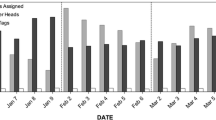Abstract
Strategic use of environmental information may have as consequence that a benevolent environmental agency will choose not to disclose information leading to reduced moral motivation. Thus, decision makers will not have access to such information, implying that they will not be able to adjust their decisions to available information on the state of the environment. In contrast, if the benevolent environmental agency instead bases its regulation on standard economic instruments, these instruments will incorporate all available information.
Similar content being viewed by others
References
Andreoni J (1990) Impure altruism and donations to public goods: a theory of warm-glow giving. Econ J 100: 464–477
Bergstrom T, Blume L, Varian H (1986) On the private provision of public goods. J Public Econ 29: 25–49
Brekke KA, Kverndokk S, Nyborg K (2003) An economic model of moral motivation. J Public Econ 87: 1967–1983
Grossman SJ (1981) The informational role of warranties and private disclosure about product quality. J Law Econ 24: 461–483
Helm D, Hepburn C, Mash R (2003) Credible carbon policy. Oxford Rev Econ Policy 19: 438–450
Kallbekken S, Westskog H, Mideksa TK (2010) Appeals to social norms as policy instruments to address consumption externalities. J Socio-Econ. doi:10.1016/j.socec.2010.02.007
Kydland FE, Prescott EC (1977) Rules rather than discretion: the inconsistency of optimal plans. J Pol Econ 85: 473–492
Milgrom P, Roberts J (1986) Relying on the information of interested parties. RAND J Econ 17: 18–32
Nyborg K, Rege M (2003) Does public policy crowd out private contributions to public goods?. Public Choice 115: 397–418
Owen AL, Videras J, Wu S (2008) More information isn’t always better: The case of voluntary provision of environmental quality, mimeo, Hamilton College (http://ssrn.com/abstract=1264059)
Rogoff K (1985) The optimal degree of commitment to an intermediate monetary target. Q J Econ 100: 1169–1189
Tirole J (1986) Hierarchies and bureaucracies: on the role of collusion in organizations. J Law Econ Organ 2: 181–214
Author information
Authors and Affiliations
Corresponding author
Additional information
I thank Ted Bergstrom, Laura Grant, Cameron Hepburn, Steinar Holden, Tore Nilssen and Karine Nyborg for helpful suggestions, participants at the workshop “Voluntary Approaches to Environmental Protection” at the Bren School at UCSB and the CBE Conference on Behavioral Economics at WWU for comments, the Economics Department at UCSB for hospitality, and the Research Council of Norway through the project “Norms, green agents and environmental policy” for financial support.
Rights and permissions
About this article
Cite this article
Asheim, G.B. Strategic Use of Environmental Information. Environ Resource Econ 46, 207–216 (2010). https://doi.org/10.1007/s10640-010-9353-x
Accepted:
Published:
Issue Date:
DOI: https://doi.org/10.1007/s10640-010-9353-x




